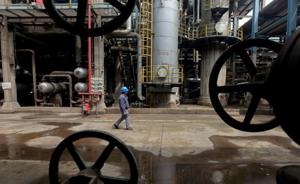Saudis, Mideast producers vie for China's teapot crude imports
(Reuters) Top global oil exporter Saudi Arabia is looking at new ways to sell crude to China, offering more cargoes at spot prices and more lenient payment terms after losing ground in the world's fastest-growing oil import market to Angola, Russia and others.
Independent refiners, known as teapots, have shaken up China's oil industry this year, accounting for most of its crude import growth since receiving import licenses for the first time near the end of 2015.
Most of this new demand is for high-quality, low-sulfur crude from non-OPEC producers, or for high-sulfur grades that sell at heavy discounts to Saudi prices, making it tough for state-owned Saudi Aramco to maintain market share.
Facing a stubborn global oil glut, and having failed to capitalize on Chinese demand growth, Saudi and fellow Gulf OPEC members have offered to cut their production by 4%, sources said on Thursday.
Industry sources say Aramco cannot sustain high output levels for long amid low oil prices.
"Saudi Arabia shifted gears and abandoned the strategy of prioritizing market share simply because it proved ineffective," RBC Capital analyst Mike Tran said.
"The Kingdom squandered market share in the US and China and failed to increase its foothold in India."
Middle Eastern sellers have seen their exports to China grow at less than half the pace of others in 2016, their smallest contribution since 2012, pulled down by 1% growth from Saudi Arabia.
Teapots refiners instead bought more oil from Angola, which has less sulfur than most Mideast grades, and Venezuela, which offers cheaper high-sulfur grades.
"It's hard at the moment because the heavy crude that we're using is from Venezuela which has a very high sulfur so we cannot add Middle East grades into our mix," said Zhang Liucheng, vice president at Shandong Dongming Petrochemical, the largest Chinese independent refiner.
Teapot purchases, along with buying by state giants such as Sinopec and PetroChina, have propelled China's imports to record highs this year. In September, China eclipsed the United States as the world's top buyer of foreign oil, according to customs data.
Teapot bottleneck. Most of China's independent refineries are designed to process crude of about 1.5% sulfur, Zhang said. The refiners could buy crudes with that level or lower, or take higher-sulfur grades to blend with sweet grades.
Dongming, for example, takes Venezuelan crude with 2.5-2.6% sulfur, he said, in competition to oils from Saudi Arabia, Kuwait and Iran.
Teapot refiners also tend to buy from sellers that offer more flexible deliveries, volumes and payment terms than typically available from Middle Eastern suppliers, who usually try to lock clients into long-term contracts.
Aramco is trying to keep that long-term model by negotiating to sell large volumes to a group of independent refiners in China in one annual contract, a senior industry source familiar with the company’s operations said.
Until it is able to lock in a contract, however, Aramco is showing some flexibility in selling crude to the teapots, offering smaller cargoes to the refiners on a spot basis, said a second source familiar with the matter.
"Aramco can't depend on the big state (Chinese) buyers alone," the second source said.
Saudi Aramco did not reply to an e-mail seeking comments for this story.
Storage expansion. To help supply China's new buyers, Aramco is expanding its oil storage capacity in Okinawa in southern Japan by nearly a third, Middle East oil sources said.
The state oil company started storing crude in Okinawa in 2011, sending supertankers to Japan and from there selling smaller cargoes on to Asian buyers.
In April this year, Aramco sold its first cargo of Arabian Heavy crude to a Chinese independent refiner from Okinawa in a trial spot shipment.
Saudi Arabia is also looking at setting up storage in China, with the two countries signing a memorandum of understanding to consider the matter earlier this year.
"The way to compete in China and Asia in general ... when Russia is supplying crude via pipeline is to be closer to your customers," said a third industry source.
"Having crude storage in China and the expansion of Okinawa is the way to do exactly that."
Saudi Arabia is still the biggest supplier to China over January-September, but on a monthly basis it has only held the top spot three times this year.
Russia and Angola have mostly taken the lead this year, with their crude exports to China growing 25% and 18%, respectively.
Saudi sales to China - which doubled to more than 1 MMbpd in 2011 from 500 Mbpd in 2007 - have barely grown since.
"If China demand keeps going up can Saudi production keep going up? To keep your share, you have to increase as demand increases. Saudi cannot do that," said an OPEC watcher.
Kuwait, Iraq and the United Arab Emirates have also been looking to sell more oil to China's rising teapot importers, but so far it is not clear how many deals have been struck.
Reporting by Rania El Gamal and Florence Tan; Additional reporting by Aizhu Chen, and Gavin Maguire and Mark Tay; Editing by Tom Hogue and Lincoln Feast







Comments